by Elisabeth Hellenbroich
“Jheronimus Bosch- visions of a genius” is the title of an art exhibition in the Museum Het Noordbrabants Museum which is shown since 15th of February in the city ’s- Hertogenbosch in order to commemorate the 500 year death anniversary of one of the most famous Netherland painters. The exhibition was organized in cooperation between the “Jheronimus Bosch 500” Foundation (founded in 2009) and the “Bosch Research and Conservation project”.
Fifty lending institutions from Europe and the US contributed to the effort which for the first time presents the entire original work of Bosch, including painting fragments having been distributed over different museums that were put together. An important part also includes part of Bosch’s drawings. By applying most modern optical techniques, such as infrared reflectography and microscopic research, the Bosch Research and Conservation Project was able with the help of samples taken from various paintings to prove which ones of the paintings were directly created by Bosch, and which ones were created by his successors in workshops. Altogether the exhibition presents about 25 panel paintings and triptychs as well as drawings which were created between 1480 and 1516 by Bosch.
A prophetic message
What can Hieronymus Bosch tell the viewer 500 years after his death, in 2016? Bosch painted the real world, the way he saw it at his time, but he also left his “visions” of this world. In a situation where mankind is facing monstrous crimes against humanity, Bosch’s paintings leave us the message that there can and will be redemption of man through God. In numerous paintings he paints hell – as one “Die Zeit magazine” commentator saw it – the “equivalent to the hell of Verdun” (battle field during the first world war 1914-18), of Hiroshima, of burning cities and bombing wars that we witness today in barbarous numerous wars in the Mideast.
We know very little about Bosch’s life. He was born on the 9th August 1450 and he died at the age of 65 in 1516, and is buried in the Sint-Jans Cathedral in the northern Brabant City ’s- Hertogenbosch. The ancestors of Bosch were the van Aken family. His grandfather and father were painters, as well as two of his elder brothers. Bosch married Aleid van de Mervenne and spent his entire life living in the center of the trade city ’s-Hertogenbosch. We don’t know where he studied nor whether he, who was one generation older than Dürer and Michelangelo, travelled to Italy or Spain. Among the people who at the time ordered his paintings were among others the Duke Philip the Fair whose duchy was part of the Habsburg Brabant and the Spanish King Philip II.
Bosch’s main works
Among the main works of Bosch are the famous triptychs, such as the “Hay Cart Triptych” (1510-16), a huge oil painting on wood that can be seen today in the Spanish National Museum Prado in Madrid. Aside this triptych there are numerous paintings devoted to the life of different Saints with whom Bosch closely identified: these include Saints like St Antonius, St Hieronymus, St Christopherus, St.John the evangelist et al. Other paintings are dedicated to the subject of man’s pilgrimage through life, epitomized in the triptych “The Vagabond” (as the exhibition demonstrates after a careful reconstruction, it was part of a triptych which included the “Ship of Fools” (Paris Louvre) and “Gluttony and lust” (New Haven, Yale university Art Gallery 1500-1510). “The Vagabond” shows a lonely man who is coming from somewhere and is going somewhere. The viewer sees a man walking his way like on a pilgrimage and, like him, he must decide where he wants to go. There is behind the vagabond an owl sitting on a tree watching the scene.
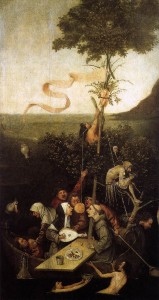
“The ship of fools” which originally was part of this “The Vagabond” triptych, is a continuation of the motive. We see a mixed society which indulges the consumption of alcohol, sweets, love and music ( see also Gluttony and Lust). The ship is not steered by anybody and on the ship’s mast there is an owl sitting, observing the scene. The men and women do not realize that they are being watched in their sinful behavior. They just spend their time in idleness and earthly pleasures.
Aside the pilgrimage subject, Bosch devoted a lot of attention to the life of Christ, such as the passion of Christ, expressed in the most outstanding painting “Ecce homo” (Frankfurt Städel Museum). But he also leaves us the vision which he had about life after death, the end of all times, epitomized in the paintings the “Final Judgement”. The viewer is confronted in those paintings with the suffering of a sinful mankind and the message given by Bosch is that man should reflect about the “ephemeral” and see this in relation with the “eternal” Goodness of God.
Hence the paintings about heaven and hell. Hell – as he demonstrates in his painting – is “treason” where the damned are tortured by satanic monsters for the sins which they committed during their “earthly life”. He paints a world in which human beings are fixated on themselves, they are godless creatures; they forget God by transforming the garden of the world into a world filled with infantilism and selfishness, which will inevitably lead them to hell. Hell is everywhere, Bosch tells us, and it is present in every epoch of mankind’s history.
Reality and Bosch’s vision
As the excellent catalogue put together by Matthijs Ilsink and Jos Koldeweij (Belser Verlag 2016) emphasizes, Hieronymus Bosch lived in two universes: one is the reality of his period, the other is the reality of his visions. The real world was created by God and is guided by God. In this world God created man in his image; unlike the animals man is endowed with reason; he is responsible for himself and must decide between good and evil. While on the one side Bosch closely observed the reality of his period, he created on the other side his own world, a universe in which imaginary creatures exist, tree-men, mixed creatures and monsters. He thus articulated his visions about the underlying “reality”, in order to have us reflect about the reality which he had seen and shown.
Bosch’s message coheres and fits well into the “devotio moderna”, a spiritual religious reform movement at his time, represented by people like Geert Groote (1340 -1384), which put emphasis on the fact that man is responsible for his decisions, that he should reflect and then decide which way he wants to go in his life. He must read the bible in his own language in order to receive the Christian message and live in the “imitation” of Christ.
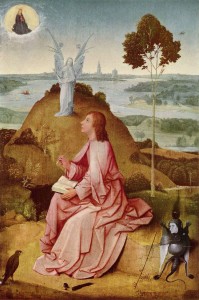
There is the painting “John in Patmos” .We see the evangelist St. John who on Patmos wrote down what he saw as apocalyptic vision for the New Testament. He is sitting silently looking at an angel who stands on top of a mountain to his right side. The angel is pointing to heaven, where we see Virgin Mary; she sits in front of the moon. St. John holds a pencil in his right hand; he is going to write what he sees, known as the apocalyptic revelation of John the evangelist. What he sees is a long apocalypse, the four apocalyptic riders, the locust plagues, plagues, fire storms, earth quakes, catastrophes which result from man’s irresponsible and sinful attitude in God’s creation.
Between Heaven and Hell
There is the famous “Heuwagen Triptych (Hay Cart)” . At the center of the triptych “Hay Cart” we see a crowd in total turmoil. It is being watched by resurrected Christ, who is looking upon the people from heaven. There is also an owl sitting on top of a bush, watching the scene (a recurring motive in Bosch’s paintings). The hay cart is pulled by a group of devils, followed by a procession of people that represent different social ranks of society, including the Emperor, Pope, the King, Dukes and the simple people. Around the hay cart people are gathered in order to scratch some hay with their hands. The whole thing is accompanied by various scenes where brutal murder and killings occurs, being unnoticed however. The people seem to run after the hay, as if it was gold. Hay symbolizes “transience”, the commentator writes in the catalogue. The weed dries and perishes at the end to nothing. Hence the message given by the painter that those who are fixated to their “earthly property”, are steering into hell, as is illustrated on the right side of the painting.
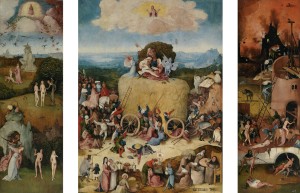
On the left side of the triptych we see the earthly paradise. It shows the first human couple created by God at the beginning of his creation, which after sinning got expelled from paradise. It also shows angels who are falling down from heaven. The threat and the temptation of evil exist within creation from the beginning. Yet contrary to the beast, man has the god given capacity of reason and a free will. Bosch emphasizes here that each human being must personally make the right decision, which way to go in his life.
Life and passion of Christ
Bosch was very focused on the passion of Christ, the Son of God who was humiliated by mankind, tortured and crucified, sacrificing his life in order save mankind from the “original sin”. The painting is created in such a way that the viewer must recognize himself, on the one side in the suffering Christ, on the other side in those sinners who let Christ suffer.
An illustrative example is the famous painting “Ecce Homo” (1475-85 Frankfurt Städel Museum). Bosch painted a scene taken from the passion cycle of Christ. We see a tortured Christ who is presented to a crowd by Pontius Pilatus. Pilatus points with his finger onto Christ “Ecce homo” in front of the crowd and the crowd shouts back “Crucifige eum” Crucify him.
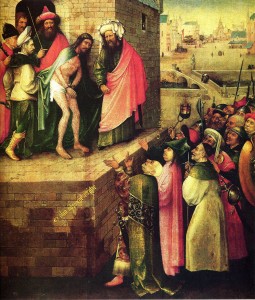
In the back of the painting we see the panorama of the city of Jerusalem. Some people at this early hour in the day are walking through the city, not noticing at all the drama which is taking place in front of the painting. At dawn Christ got arrested, he became a prisoner and was sentenced to death – as result of a totally unjust trial. The moment we see in the painting is when Christ is presented by Pilatus to a crowd of grinning and shouting people. Their faces are distorted, angry and evil. The weak body of Christ is covered with bloody wounds, expressing the immense sacrifice which he did for the sake of all human beings. Bosch intended to have the viewer come to this understanding and to feel that effect.
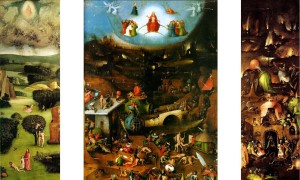
The end of all times
In the “Final Judgement Triptych” (Brügge 1495-1505) Bosch reflected about his visions which he had about the final judgement. It is the day when the physical world comes to an end and when the dead will resurrect. On the left side we see “earthly sunny paradise”, the blessed will be guided on their way to heaven to the right side of God. On the right side of the painting, we see how the damned souls are driven along a scorched earth into hell. Bosch painted with a special technique with light colors on a black underground. He painted what he saw as the perspective for all human beings, including the good and the bad ones, after the final judgement.
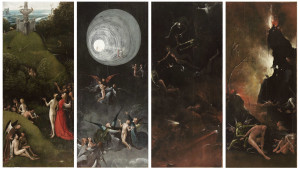
In his painting “Visions about afterlife” he reflects in four spectacular visions about the horrible fall of the damned and the river leading to hell; on the other side he shows the earthly paradise which gives hope and shows the reception of the blessed into heaven. There is the vision of a tunnel at the end of which some angels welcome the souls in eternal light. It underlines what Bosch wanted to say in essence: As horrendous as the crimes against humanity are, man should decide for the good and use this as a starting point not to give up his hope for redemption.
Wiesbaden, March 2016
Pubblicazione gratuita di libera circolazione. Gli Autori non sono soggetti a compensi per le loro opere. Se per errore qualche testo o immagine fosse pubblicato in via inappropriata chiediamo agli Autori di segnalarci il fatto e provvederemo alla sua cancellazione dal sito




